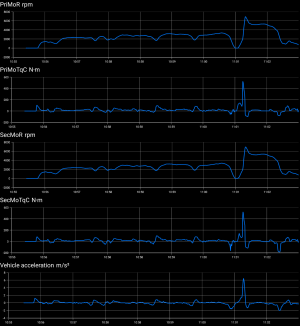This is another “So hear me out” post by yours truly.
Low Speed Overdrive would be a game changer in some situations and would make more sense than a Front Dig.
We had quite a few scale RC rock crawlers in storage and I recently got them all back out now that the kids are getting old enough to play with them. So this weekend I tore them all down and started getting them running again.
Most of them have the same differential ratios which is awesome for trail running, but one of our SCX24 Jeep Rubicons has a set of brass axles with an overdrive gear in the front differential. It is incredibly capable when you are climbing obstacles, but it doesn’t like full speeds for long periods of time.
An overdriven drivetrain has mismatched differential gears with a numerically higher ratio in the front. So basically your front tires always turn faster than your rear tires which has its own pros and cons.
Typically 10%-20% overdrive is acceptable for trails and higher speeds while 24%-30% are used in competition rock crawlers. Having a front overdrive can also make turning with your lockers engaged much easier on you as well as your vehicle.
Am I comparing Scouts to remote controls cars? Yeah I guess I am. But many people have given their lives so I can say stupid things on the Internet, where nobody knows I’m really a dog.
Woof (I digress)
A big benefit of the Scouts having a divorced drivetrain is you can drive each axle separately.
But when you have both lockers engaged in low speed situations, specifically inclines, it would be awesome if the front motor could be manually sped up to a faster rate than the rear. And while I expect this to already be a feature managed by the Traction Control system regardless if the lockers were engaged, I would love being able to adjust it myself within a reasonable range.
Maybe around 10%, give or take with a few levels of adjustment.
Obviously not an ideal feature for higher speeds with any meaningful traction for any period of time, but in some specific low-traction scenarios it may be really useful. Snow, loose rock, wet rock shelf’s. Etc.
It could disengage in speeds above 5mph and when the vehicle is on level or down-sloped terrain to prevent drivetrain stresses and undesirable steering behavior.
Having the ability to pull yourself over an obstacle is a lot safer than having to “bump it” and jab the throttle as often. Slow controlled crawling is the way to go and puts a lot less stress on your body as well as your off-roading Connection Machine.
But it would also be beneficial when you are making sharp turns in low traction situations like switchbacks covered in loose rock, snow, or soil.
That’s because the front motor would be pulling you forward in the direction you want to go, and the rear axles would push at a slower rate to make long vehicles feel even shorter offroad as it drags the rear tires to pivot around obstacles or hazards.
It could be a feature already enabled in specific offroad modes like Rock Crawl Mode or Snow/Mud Mode to varying degrees already and this could all just be a fever dream.
I’m going to go do human things now. Good night.
Low Speed Overdrive would be a game changer in some situations and would make more sense than a Front Dig.
We had quite a few scale RC rock crawlers in storage and I recently got them all back out now that the kids are getting old enough to play with them. So this weekend I tore them all down and started getting them running again.
Most of them have the same differential ratios which is awesome for trail running, but one of our SCX24 Jeep Rubicons has a set of brass axles with an overdrive gear in the front differential. It is incredibly capable when you are climbing obstacles, but it doesn’t like full speeds for long periods of time.
An overdriven drivetrain has mismatched differential gears with a numerically higher ratio in the front. So basically your front tires always turn faster than your rear tires which has its own pros and cons.
Typically 10%-20% overdrive is acceptable for trails and higher speeds while 24%-30% are used in competition rock crawlers. Having a front overdrive can also make turning with your lockers engaged much easier on you as well as your vehicle.
Am I comparing Scouts to remote controls cars? Yeah I guess I am. But many people have given their lives so I can say stupid things on the Internet, where nobody knows I’m really a dog.
Woof (I digress)
A big benefit of the Scouts having a divorced drivetrain is you can drive each axle separately.
But when you have both lockers engaged in low speed situations, specifically inclines, it would be awesome if the front motor could be manually sped up to a faster rate than the rear. And while I expect this to already be a feature managed by the Traction Control system regardless if the lockers were engaged, I would love being able to adjust it myself within a reasonable range.
Maybe around 10%, give or take with a few levels of adjustment.
Obviously not an ideal feature for higher speeds with any meaningful traction for any period of time, but in some specific low-traction scenarios it may be really useful. Snow, loose rock, wet rock shelf’s. Etc.
It could disengage in speeds above 5mph and when the vehicle is on level or down-sloped terrain to prevent drivetrain stresses and undesirable steering behavior.
Having the ability to pull yourself over an obstacle is a lot safer than having to “bump it” and jab the throttle as often. Slow controlled crawling is the way to go and puts a lot less stress on your body as well as your off-roading Connection Machine.
But it would also be beneficial when you are making sharp turns in low traction situations like switchbacks covered in loose rock, snow, or soil.
That’s because the front motor would be pulling you forward in the direction you want to go, and the rear axles would push at a slower rate to make long vehicles feel even shorter offroad as it drags the rear tires to pivot around obstacles or hazards.
It could be a feature already enabled in specific offroad modes like Rock Crawl Mode or Snow/Mud Mode to varying degrees already and this could all just be a fever dream.
I’m going to go do human things now. Good night.
Last edited:
Upvote
1

